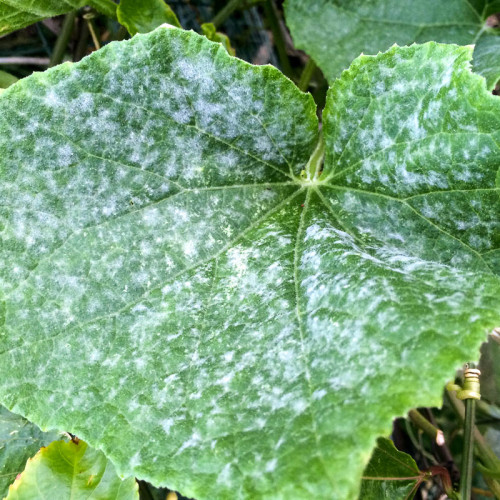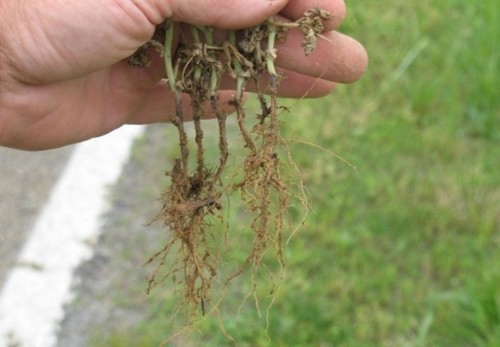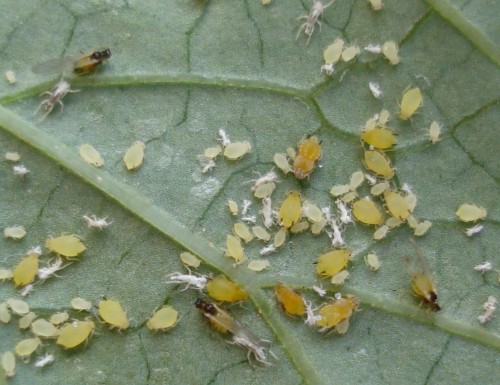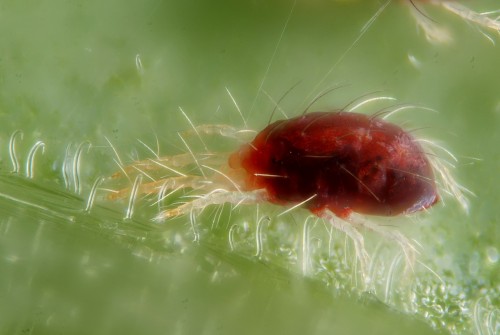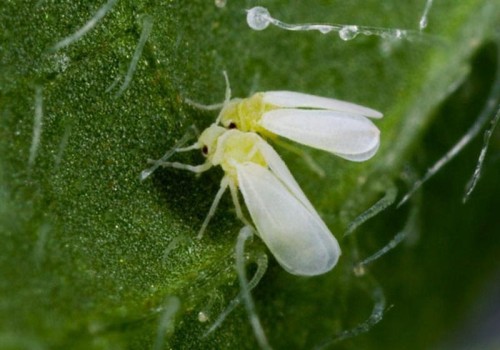The cultivation of cucumbers implies a set of events. One of them is the correct protection against pests and diseases. After all, the yield of agricultural culture directly depends on this.
General preventive measures
To obtain a normal and high-quality crop of cucumbers to adhere to a number of requirements. These include the following:
- only seeds are sown, which are subject to disinfection and preparation;
- the soil should be fertile, loose, clean, fertilized and heavy (up to + 14ºС at a depth of 8 cm);
- crowwards should be observed, which involves the cultivation of cucumbers in one site after 2-3 years (during seeds in the greenhouse, it is necessary to replace the upper fertile layer of soil annually);
- removal from the site of all residues of vegetation (it is best to burn them);
- seeds are used, which are maximum resistant to diseases and pests;
- in the greenhouse there is a constant ventilation (warm and dry medium contribute to the active growth of vegetables);
- the cultivation of cucumbers is recommended to be carried out on the site where tomatoes, potatoes and legumes grew;
- it is forbidden to land seeds in the place where the pumpkin or zucchini was located last summer.
There are several pests and cucumber diseases. To combat them it is necessary to choose the most effective way.
Plant Diseases and Fighting
Puffy dew
It is the most common disease. The characteristic feature is the lesion of the leaves (very rarely cherries, stems and fruits). White stain covers the top of the leaf, gradually covering it completely. After some time, the plant becomes brown. There is a falling whole weaves. The quality and number of vegetables decreases.
The main causes of the appearance of malievous dew:
- high humidity and pops of crops;
- the presence of temperature differences;
- growth of weeds;
- watering too cold water.
The elimination of this cucumber disease (in the photo) can be carried out by:
- removal and burning of affected leaflets;
- treatment with 0.3% colloidal gray (25-30 g per 10 liters of water) or sulfur hammer (30-35 g on a plot area of \u200b\u200b10 m²);
- making potassium feeding;
- spraying leaves on both sides with liquid cow manure with urea (on 10 liters of warm water of 1 liter of manure and 1 tbsp. urea);
- the use of chemical preparations (oxyhoma or topaz);
- the destruction of weed residues and other vegetation.
Peronosporosis at the cucumbers
It is manifested in the appearance on the top of the leaflets of yellow-green spots of various shapes that have a light green flare. The lower part of the peridosporosis leaves is painted in purple color. Due to the transfer of the wind, the spread of cucumber disease occurs instantly. Therefore, it is impossible to slow down with its elimination. Planting cucumbers in such a plot follows 5-7 years.
Causes of pericorosis:
- the presence of permanent condensate (fog, dew);
- sharp temperature fluctuations in day and night;
- cold watering.
The fight against peristosposition provides for the choice of one of these options:
- the use of potassium permanganate;
- treatment of urea (1 g / 1 l of water) or lactic serum (10 liters of water 1 l of milk and 10 drops of iodine);
- making feeding;
- spraying with 1% burgundy liquid (on 10 liters of water of 100 g of lime and copper vapor);
- the use of risoplan fungicide.
The main way to combat peronosporosis is to properly carry out preventive measures:
- acquisition of hybrids resistant to diseases;
- sowing early varieties;
- compliance with the optimal temperature and humidity modes;
- ventilating greenhouses;
- collection, plant burning and watering beds with copper vitrios after final harvest.
Root rot from cucumbers
The appearance of yellow and sharp wiping of well-growing and blooming cucumbers indicate the damage to the roots of plants. In most cases, the root rot becomes the cause of this phenomenon. This can be verified if you switch the stalk of the plant in the ground. He will be crazy and yellow.
The main reason for the appearance of the root rot - landing of cucumbers in one site for several years in a row. Most often the development of cucumbers in the greenhouse occurs.
To prevent the root rot, they should adhere to such measures:
- watering is carried out only with warm water;
- landing seeds are not carried out in heavy soil and for too much depth;
- in greenhouses are not allowed high humidity;
- removal of all weed vegetation.
You can get rid of the root rot in the early stages of the disease in one of two ways:
- The stem is broken up to the root and pumped with wood aslands or chalk.
- The roots are processed by a solution for the manufacture of which water (0.5 l) is used, lime (3 art. L.) And copper sipop (1 tsp.).
If the cucumbers failed to save, then:
- they should be carefully removed from the site;
- treat the garden with dry chlorine lime (180-200 g / 1 m²);
- all tools wash with washing powder.
ClapPoriosa at the cucumbers
It is a viral disease that affects the fruit. Small and watery spots cover cucumbers. Over time, the cucumber cracks and acquires curve form. The leaves also change the form, and all the maritime dies after a week (if you do not take action).
Causes of ClapPoriosis:
- use in the greenhouse of the old polyethylene film;
- increased humidity;
- watering sprinkling;
- weed vegetation.
The fight against the disease involves:
- sowing seeds resistant to kestoshipiosis;
- ventilating greenhouses;
- termination of watering for 6-7 days;
- making feeding with potassium sulfate;
- spraying by burgundy liquid (15%).
White rot from cucumbers
The mucus and plaque covers all parts of cucumbers: leaves, stems, flowers and mustaches. Especially often white rot is evolving in conditions of high humidity. For example, in greenhouses.
You can get rid of the disease with:
- soil disinfection (on 10 liters of water 10 g of urea and 3 g of copper sulfate, flow rate - 1 l / 10 m²);
- cutting the contaminated parts of vegetables and powders ashes or lime;
- rare sowing seeds.
Anthracnose of cucumber
Circular spots of brown and pink hit cucumber leaves. Bushes begin to darken, and the fruit becomes wrinkled. If wet weather prevails, the disease spreads to the roots of plants.
In order to prevent the occurrence and elimination of anthracnose:
- seeding is carried out in a sufficiently heated ground;
- observed rotation scheme;
- completely destroyed the weeds and crop residues;
- plants sprayed with Bordeaux liquid (1 time per week for 5-6 days before harvesting);
- cucumber treated with bleach (40-45 grams per 10 liters of water, 1 time for 8-10 days 20-22 days before harvest).
Pest management
aphis gossypii
By the size of these pests cucumber about 2 mm. Characterized by a dark green oval-shaped body. Females do not have wings. Can produce up to 15-20 generations per season.
Aphis gossypii eats all parts of the plant: leaves, flowers, fruit. The flowers fade and the leaves fall off. The presence of wet environment will make it impossible to save the crops.
Insect following methods must be used:
- When a small amount of pests using the soap solution with the addition of hull bow (10 liters of boiling water is poured to 50 g of soap and 500 g of husk) or a mixture of ash (250 g ash, 60 g of soap, a bucket of water). crop processing is carried out 2 times with a 5-day intervals.
- When the mass reproduction of aphids used malathion (3 g / m² 1) preparations "Fitoverm" (8-9 ampoule per liter, the expense - 1 l / m² 10) and "spark" (tablet 8-9 liters, the flow rate - 1 liter / 10 m²). After applying means portion at night covered with polyethylene.
In order to prevent occurrence of aphid follow these preventive measures:
- complete destruction of weeds;
- conduct timely watering;
- planting related crops that repel pests (coriander, mint, mustard, garlic and basil).
Spider mite in cucumber
This sucking pest, wherein the red-green, located on the ground adjacent to the side of the sheet. The insect feeds on sap green leaves. Consequently deteriorates photosynthesis process. What causes complete defoliation.
In most cases, spider mites appear in spring in a greenhouse not folding. Females pests without problems transferred winter design. After that entangle the web of leaves and lay up to 150 eggs at one time (in hot weather females can output up to several generations). Hatched larvae grow for 2 weeks.
The effective struggle against pests of cucumbers implies the implementation of such actions:
- soil moisturizing;
- annual replacement of the upper fertile soil layer in the greenhouse;
- cleaning the section from weed vegetation;
- the use of means containing phosphorus;
- spraying of shoots onion mixture twice with an interval of 5 days (10 liters of water, 1 glass of crushed on the meat grinder, 1 tbsp. l. liquid soap and black ground pepper, 3 tbsp. Wood ash);
- processing of plants with an infusion of 60 g of a broken bitter pepper, 5 tbsp. l. Wood ash, 1 tbsp. l. soap and water buckets;
- landing near the cucumbers of dill, which will attract God's cows (they eat cute ticks).
Bellenka at cucumbers
It is a small prolific and voracious insect. The whitefold shows the maximum activity at the end of July - early August. The pest displays the larvae, flying from one bush to another. The leaves of the cucumbers are covered with fungi, become black and begin to fade.
To combat the blonde, drugs are used:
- "Inta-Vir";
- "Fosbecide";
- "Confan".
You can also try:
- washing insects from the leaves of a strong jet of water;
- placing sticky tapes;
- shallow soil looser (up to 2 cm) and peat rash;
- planting tobacco near the cucumbers (he will attract the whitefly, after which the tobacco is treated with a chemical agent).
Radovaya Fly Cucumbers
This pest is laying eggs to the ground in early May. The emerging larvae reaches 7 mm. They penetrate the inside of the stalks of plants. Two weeks of larvae, wearing greens, become adult individuals who also give offspring. Sometimes pests do not allow cucumber seeds to even get out of the ground.
You can eliminate insects only by:
- deep loosening soil before planting;
- disembodies sprouted seeds;
- use of growth stimulants when soaring seeds;
- applications in the greenhouse of the finished compost;
- the destruction of all weeds and thoroughly jumping the area after harvesting.
Ants - harm for cucumbers
These insects are able to damage the root cucumber system. They are also the main reason for the appearance of the Tly.
To destroy ants, you will need:
- as much as possible to loosen the earth;
- process the piece of wood ash or haired lime;
- obtain anthills with boiled water;
- lay out traps (bottles filled with sweet syrup).
Slug - harm for cucumbers
The eating of the greenery and the damage of the fruits at night is the "tricks" of the lodge. The crop of cucumbers will also be spoiled by the litter of pests.
The fight against slugs is carried out by:
- introduction into the soil hawed lime or wood ash;
- processing "Metaldehyde";
- removal of weed vegetation;
- creating structures where there will be slugs during the daytime (cardboard, boards, small logs, old dishes), with the subsequent destruction of pests.
Video about ways to combat diseases and pests of cucumbers:


